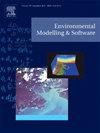一种有效的数据驱动方法,用于从总组合下水道流量数据中分离干燥天气流量
IF 4.8
2区 环境科学与生态学
Q1 COMPUTER SCIENCE, INTERDISCIPLINARY APPLICATIONS
引用次数: 0
摘要
由于多个水流源之间的动态相互作用,污水处理厂往往需要适应大范围波动的流量。废水管理,特别是综合下水道溢流(CSO)缓解方面的一个主要挑战是将下水道总流量分解为其组成部分:干燥天气流量(DWF)和雨水流入和渗透(RDII)。虽然目前的方法在干燥气候中取得了成功,但它们需要过滤掉受降雨影响的数据,这往往导致对潮湿和半潮湿气候或季节的流量成分的估计不准确。本研究中开发的双趋势残差法(TDRM)是一种数据驱动模型,旨在利用所有可用数据来缓解这一缺点。我们将TDRM与从俄亥俄州大辛辛那提大都会污水区三个地点和时间段收集的污水流量数据一起实施,并证明它可以成功地将含雨流量数据集解耦到每周DWF和RDII组件中。本文章由计算机程序翻译,如有差异,请以英文原文为准。
An efficient data-driven method for isolating dry-weather flow from total combined sewer flow data
Wastewater treatment plants in combined sewer systems are often required to accommodate the widely fluctuating flow due to the dynamic interactions between multiple water flow sources. A major challenge in wastewater management, and particularly in combined sewer overflow (CSO) mitigation, is decoupling the total sewer flow into its components: dry-weather flow (DWF) and rain-derived inflow and infiltration (RDII). While current approaches have been successful for dry climates, their requirement to filter out rainfall-affected data often leads to inaccurate estimates for flow components in wet and semi-wet climates or seasons. The twice-detrended residual method (TDRM) developed in this study is a data-driven model that seeks to alleviate this drawback while utilizing all available data. We implement TDRM with sewer flow data collected from three locations and time periods within the Greater Cincinnati, Ohio Metropolitan Sewer District, and demonstrate that it can successfully decouple rain-inclusive flow datasets into their weekly DWF and RDII components.
求助全文
通过发布文献求助,成功后即可免费获取论文全文。
去求助
来源期刊

Environmental Modelling & Software
工程技术-工程:环境
CiteScore
9.30
自引率
8.20%
发文量
241
审稿时长
60 days
期刊介绍:
Environmental Modelling & Software publishes contributions, in the form of research articles, reviews and short communications, on recent advances in environmental modelling and/or software. The aim is to improve our capacity to represent, understand, predict or manage the behaviour of environmental systems at all practical scales, and to communicate those improvements to a wide scientific and professional audience.
 求助内容:
求助内容: 应助结果提醒方式:
应助结果提醒方式:


